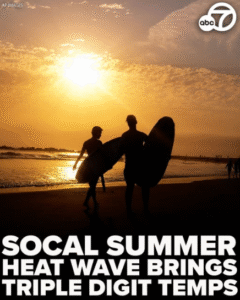Southern California remains in the grip of an intense summer heat wave as temperatures continue to soar into the triple digits across many areas on Wednesday. The sweltering conditions are being driven by a persistent high-pressure system that has parked itself over the region, trapping heat and leading to dangerously hot conditions, particularly in the inland valleys and desert regions.
The National Weather Service has issued multiple advisories and warnings. An Excessive Heat Warning remains in effect for the Inland Empire, Coachella Valley, and Mojave Desert through at least Thursday evening. In these regions, daytime highs are expected to range from 105 to 117 degrees Fahrenheit. Palm Springs could see temperatures peak near 117 degrees, while Death Valley is forecasted to hit or exceed 120 degrees. Other areas, such as Riverside, San Bernardino, and Ontario, will hover around 100 to 105 degrees.
Even the traditionally cooler coastal cities are feeling the heat, though to a lesser extent. Areas like Downtown Los Angeles, Pasadena, and Burbank are experiencing highs in the upper 80s to mid-90s. Coastal communities such as Santa Monica and Long Beach are faring slightly better, with temperatures staying in the 70s and low 80s, thanks to the influence of the marine layer. However, the relief is minimal once moving inland just a few miles.
Meteorologists warn that overnight lows will also remain unseasonably warm, with temperatures staying in the 70s and even low 80s in some places. This raises additional health risks, as the body gets less of a chance to recover from the daytime heat. Heat-related illnesses such as heat exhaustion and heat stroke become more likely under these prolonged conditions, especially for vulnerable populations such as the elderly, children, pregnant individuals, outdoor workers, and those with chronic illnesses.
Officials are urging residents to take precautions, including staying indoors during peak heat hours, drinking plenty of water, avoiding strenuous activities, and checking on neighbors and loved ones. Cooling centers have been opened throughout Los Angeles, Riverside, and San Bernardino counties, providing air-conditioned shelter for those in need. Local fire departments and emergency services are on high alert, with crews on standby to respond to heat-related emergencies and potential wildfires.
The high temperatures are also increasing wildfire risk across much of the region. The combination of dry vegetation, low humidity, and hot, gusty winds creates ideal conditions for fire ignition and spread. Several small brush fires have already been reported in Riverside and San Bernardino counties, and authorities are closely monitoring the situation. Residents are advised to avoid any activities that could spark a fire, such as using outdoor grills, machinery, or fireworks.
In addition to fire and health concerns, the heat wave is having an impact on infrastructure and energy usage. Utility providers are reporting increased demand on the power grid as air conditioning use spikes. Southern California Edison and other power companies are urging residents to conserve electricity during peak afternoon hours to avoid rolling blackouts or outages. Tips include setting thermostats to 78 degrees or higher, using fans to circulate air, and delaying the use of major appliances until evening hours.
The current heat wave is not unusual for this time of year but is notable for its intensity and duration. According to meteorologists, temperatures are expected to remain high through Thursday, with a slight cooling trend possible by Friday as the high-pressure ridge begins to weaken. However, long-range forecasts suggest that another wave of high heat may return next week, keeping the region in a heightened state of alert.
Inland residents who have limited access to air conditioning are among those most affected. Emergency management teams have deployed additional resources to underserved neighborhoods and rural communities to ensure that residents are informed and supported. Public health agencies are emphasizing that heat-related illnesses are preventable and that early signs—such as dizziness, fatigue, headaches, and nausea—should not be ignored.
Animal welfare officials are also reminding the public not to leave pets or children in vehicles, even for a short time. Temperatures inside a parked car can rise by more than 20 degrees in just 10 minutes, turning into a deadly trap. Pet owners are encouraged to walk their animals during cooler morning or evening hours and ensure they have access to shade and water throughout the day.
Environmental scientists note that these heat waves are becoming more frequent and severe, a trend consistent with the effects of climate change. Urban areas with lots of concrete and limited green space, known as urban heat islands, experience even higher temperatures. Some cities are investing in longer-term solutions such as planting more trees, installing reflective rooftops, and expanding access to public cooling infrastructure.
In summary, Southern California is enduring one of its most significant heat events of the season. While coastal areas remain relatively mild, inland and desert communities are facing extreme heat that poses serious health and environmental risks. Residents are urged to stay vigilant, practice heat safety, and use community resources where needed. With at least another day or two of excessive temperatures expected, preparation and caution remain essential.


